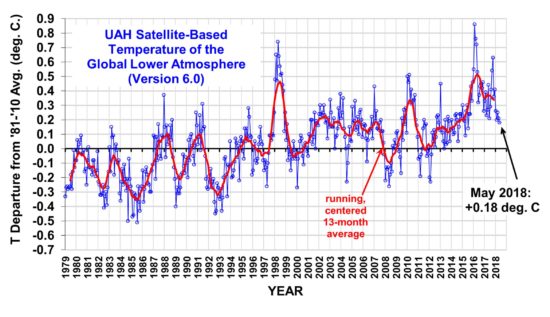trysail
Catch Me Who Can
- Joined
- Nov 8, 2005
- Posts
- 25,593
by Paul Dreisen
A new study by climatologists Nicholas Lewis and Judith Curry concludes that Earth’s “equilibrium climate sensitivity” (ECS) to more atmospheric carbon dioxide is as much as 50% lower than climate alarmists have been claiming. Their paper was published in the Journal of Climate (
The impact of recent forcing and ocean heat uptake data on estimates of climate sensitivity
https://journals.ametsoc.org/doi/10.1175/JCLI-D-17-0667.1 ) ...
...Indeed, say other noted climatologists, there are good reasons to think ECS and alarmist errors are even greater than 50 percent. For one thing, there is no persuasive reason to assume our planet’s climate system and deep ocean temperatures were ever in “energy balance” back in the late 1800s – so we can’t know whether or how much they might be “out of balance” today. Moreover, solar, volcanic and ocean current variations could be sufficient to explain all the global warming over the period of allegedly anthropogenic warming – which means there is no global warming left to blame on carbon dioxide.
If this is indeed the case, there is no justification for the punitive, job-killing, poverty-prolonging energy policies that “climate consensus” and “renewable energy” proponents have been demanding...
Dr. Roy W. Spencer (Principal Research Scientist in Climatology at the University of Alabama-Huntsville and U.S. Science Team Leader for NASA’s satellite global temperature monitoring program) commented on the paper. Even Lewis and Curry’s figures make several assumptions that are at best unknown and quite likely false. He noted:
“I’d like to additionally emphasize overlooked (and possibly unquantifiable) uncertainties: (1) the assumption in studies like this that the climate system was in energy balance in the late 1800s in terms of deep ocean temperatures; and (2) that we know the change in radiative forcing that has occurred since the late 1800s, which would mean we would have to know the extent to which the system was in energy balance back then.
“We have no good reason to assume the climate system is ever in energy balance, although it is constantly readjusting to seek that balance. For example, the historical temperature (and proxy) record suggests the climate system was still emerging from the Little Ice Age in the late 1800s. The oceans are a nonlinear dynamical system, capable of their own unforced chaotic changes on century to millennial time scales, that can in turn alter atmospheric circulation patterns, thus clouds, thus the global energy balance. For some reason, modelers sweep this possibility under the rug (partly because they don’t know how to model unknowns).
“But just because we don’t know the extent to which this has occurred in the past doesn’t mean we can go ahead and assume it never occurs.
“Or at least if modelers assume it doesn’t occur, they should state that up front.
“If indeed some of the warming since the late 1800s was natural, the ECS would be even lower.”
“We have no good reason to assume the climate system is ever in energy balance, although it is constantly readjusting to seek that balance. For example, the historical temperature (and proxy) record suggests the climate system was still emerging from the Little Ice Age in the late 1800s. The oceans are a nonlinear dynamical system, capable of their own unforced chaotic changes on century to millennial time scales, that can in turn alter atmospheric circulation patterns, thus clouds, thus the global energy balance. For some reason, modelers sweep this possibility under the rug (partly because they don’t know how to model unknowns).
“But just because we don’t know the extent to which this has occurred in the past doesn’t mean we can go ahead and assume it never occurs.
“Or at least if modelers assume it doesn’t occur, they should state that up front.
“If indeed some of the warming since the late 1800s was natural, the ECS would be even lower.”
With regard to that last sentence, Spencer’s University of Alabama research colleague Dr. John Christy and co-authors Dr. Joseph D’Aleo and Dr. James Wallace published a paper in the fall of 2016 (revised in the spring of 2017). It argued that solar, volcanic and ocean current variations are sufficient to explain all the global warming over the period of allegedly anthropogenic warming, leaving no global warming to blame on carbon dioxide. At the very least, this suggests that indeed “some of the warming since the late 1800s was natural” – which means the ECS would be even lower than Lewis and Curry’s estimate. All of this has important policy implications.
Wisely or not, the global community agreed in the 2015 Paris climate accords to try to limit global warming to at most 2 C degrees – preferably 1.5 degrees – above pre-Industrial (pre-1850) levels. If Lewis and Curry are right, and the warming effect of CO2 is only 50–70% of what the “consensus” has said, cuts in CO2 emissions need not be as drastic as previously thought. That’s good news for the billions of people living in poverty and without affordable, reliable electricity. Their hope for electricity is seriously compromised by efforts to impose a rapid transition from abundant, affordable, reliable fossil fuels to diffuse, expensive, unreliable wind and solar (and other renewable) as chief electricity sources. Moreover, if Spencer (like many others who agree with him) is right that the assumptions behind ECS calculations are themselves mistaken … and Christy (like many others who agree with him) is right that some or all of the modern warming has been naturally driven – then ECS is even lower than Lewis and Curry thought. That would mean there is even less justification for the punitive, job-killing, poverty-prolonging energy policies sought by the “climate consensus” community...

